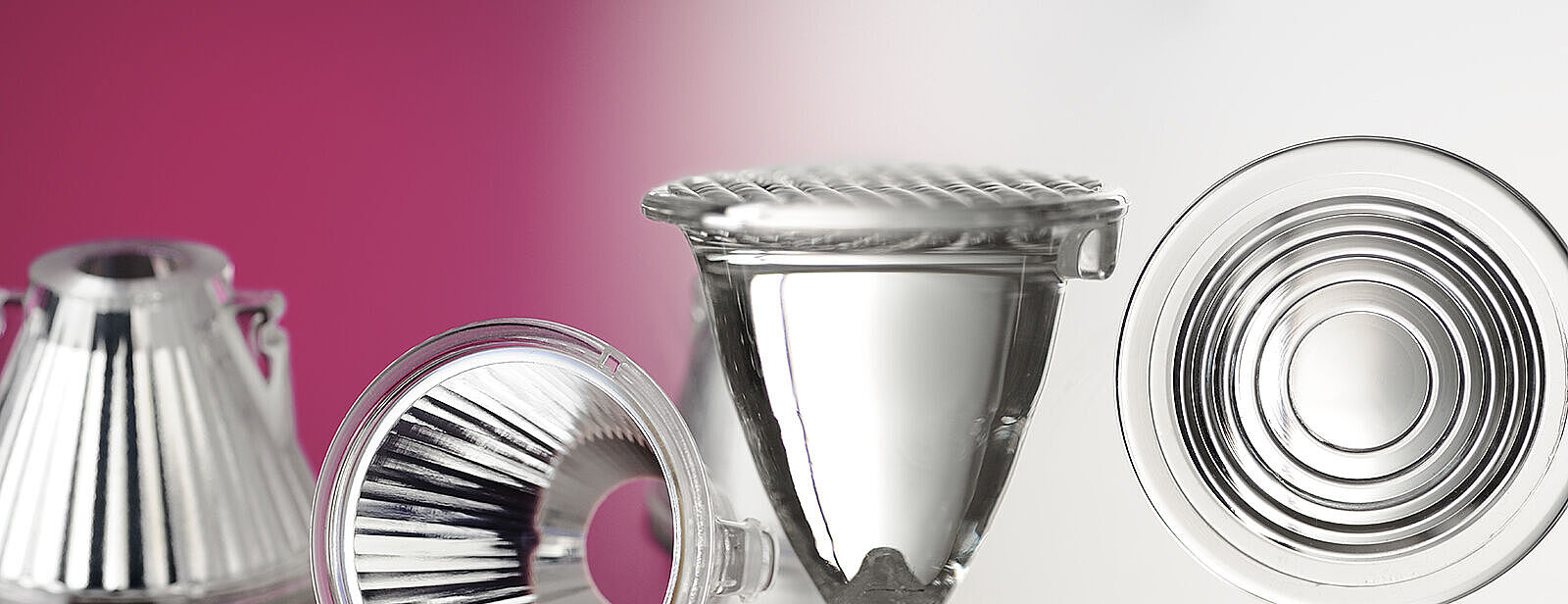
As one of the world's most experienced designer and manufacturer of optical glass components for the lighting industry, Auer Lighting highly recommends glass for LEDs. This is due to its features concerning environmental resistivity, transparency and the ability to withstand temperatures well above 300 °C without degradation. In particular, the last point is becoming of increasing interest as the power of LEDs is rising and thus producing more heat. Optics made from plastic materials will only stay stable for much lower temperatures, limiting already the potential performance of high-power lighting systems. The advantages of glass open up the possibility to use more powerful light sources that bring LED lighting to a whole new brightness level.
| Property | Glass SUPRAX 8488 | PMMA | PC | Silicone | Remarks |
|---|---|---|---|---|---|
| Density (g/cm³) | 2.31 | 1.18 | 1.20 | 1.02 | |
| Water absorption (weight %) | no | 0.6 - 2.0 | 0.1 - 0.3 | 0.2 | acc. to ISO 62 |
| Thermal expansion coefficient (10-6/K) | 4.1 | 80 | 70 | 250 - 345 | |
| Thermal conductivity λ (W/(m K)) | 1.20 | 0.19 | 0.21 | 0.31 | |
| Heat capacity (J/(g K)) | 0.80 | 1.20 | 1.17 | 1.37 | @ 25 °C |
| Flammability (mm/min) (class) | no | 25 (HB) | 2.5 (VO) | HB-V1 | UL 94 |
| Chemical resistivity | ++ | - | 0 | + | |
| Short-time operating temperature (°C) | 450 | 93 | 130 | 260 | |
| Permanent operating temperature (°C) | 400 | <80 | <110 | 150 | |
| Light transmission (%) | 92 | 92 | 89 | 91 | D = 3 mm |
| Refractive Index nd | 1.482 | 1.492 | 1.585 | 1.410 | @ 25 °C |
| Fresnel losses (%) | 3.8 7.5 | 3.9 7.6 | 5.1 9.9 | 2.9 5.7 | one surface two surfaces |
| Thermo-optic coefficient dn/dT (10-4/K) | ∼0 | -1.1 | -1.1 | -5.0 | |
| Abbe number | 65 | 59 | 31 | 50 | νd |
| Coatability | ++ | 0 | 0 | - | |
| UV resistivity | ++ | 0 | - | + | |
| Cleanability | ++ | - | - | - | |
| Possible feature size | 0 | + | + | + | |
| Yellowness index | 0 | 8 | 9 | 1 | 30 years ASTM E313 |
Glass is the perfect companion for long-lasting LEDs, due to its durability as well as versatility in shape and features. And temperature is no problem for glass. It can be easily coated (to enhance initial performance) and cleaned (to keep that initial performance).
From the cost side glass optics can reach competitive pricing levels if adequate design is accounted for, especially for specialized and/or qualitative optics. A simple copy of existing plastic optics will not do so.
Why glass has been put in second place so far in the LED world is not easily understandable. But it shows so many valuable and interesting features that no one can afford to ignore it any longer.
We use cookies. Some of them are necessary to make the website usable. Others help us display information that is relevant and engaging to you. As data protection is important to us, we ask you to decide on the scope of use. You can either accept all cookies or choose your individual settings. You can withdraw your consent at any time by reopening this tool. Thanks and enjoy our website!
This is an overview of all cookies used on this website. Please make your individual settings. You can adapt them at any time by using the "Cookie settings" link in the footer of this website.
These cookies are essential to the operation of the website, e.g. by saving your cookie settings.
| Name | alto. Cookie |
|---|---|
| Provider | Provider |
| Purpose | Saves the visitor's settings |
| Identifier | alto-cookie |
| Validity | 1 year |
Tools collecting usage data anonymoulsy, giving insights into how to improve our services for you.
| Accept | |
|---|---|
| Name | Google Analytics |
| Provider | Google LLC |
| Purpose | Google cookie for website analyses. Creates statistical data on website usage. |
| Privacy | https://policies.google.com/privacy |
| Identifier | _ga,_gat,_gid |
| Validity | 2 years |
Tools enhancing the browsing exerience, e.g. maps or videos.
| Accept | |
|---|---|
| Name | YouTube |
| Provider | YouTube, LLC |
| Purpose | Used to unlock Youtube contents. |
| Privacy | https://policies.google.com/privacy |
| Identifier | yt-remote-fast-check-period, yt-remote-session-app, yt-remote-session-name |
| Validity | Session |
| Accept | |
|---|---|
| Name | Google Maps |
| Provider | Google LLC |
| Purpose | Used to unlock Google Maps contents. |
| Privacy | https://policies.google.com/privacy |
| Identifier | NID |
| Validity | 2 Years |
| Accept | |
|---|---|
| Name | Vimeo |
| Provider | Vimeo, LLC |
| Purpose | Used to unlock Vimeo contents. |
| Privacy | https://vimeo.com/privacy |
| Identifier | vuid |
| Validity | 2 Years |